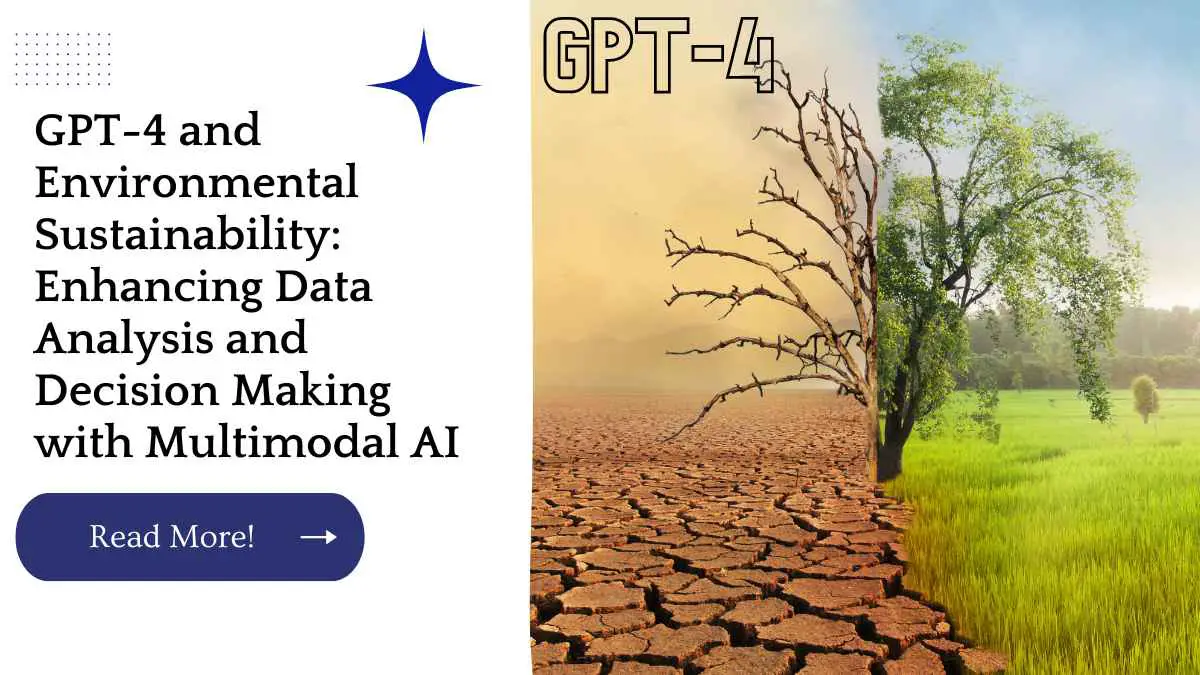The impact of human activities on the environment has become a major concern in recent years. It is important to have accurate data and insights in order to make informed decisions that will help preserve our planet for future generations.
With the release of GPT-4, a multimodal model from Microsoft-OpenAI, there is an opportunity to enhance data analysis and decision making related to environmental sustainability. In this blog post, we will explore how GPT-4 can be used to address some of the challenges related to environmental sustainability.
| Takeaways |
|---|
| GPT-4 is a new generation of AI language generation technology that uses multimodal AI to enhance data analysis and decision-making. |
| GPT-4 has the potential to revolutionize various industries, including healthcare, education, e-commerce, and media, with its advanced language processing and multimodal capabilities. |
| GPT-4 can assist in environmental sustainability by providing accurate data analysis and decision-making. |
| GPT-4 is expected to be launched in March 2023 and is anticipated to surpass its predecessor, GPT-3, in terms of performance and capabilities. |
| The development of GPT-4 has raised concerns about ethical considerations in AI and the potential impact of such advanced technology on society. |
Multimodal AI for Environmental Data Analysis
GPT-4’s multimodal capabilities can be harnessed for analyzing complex environmental data sets. By integrating text, images, video, and sound, the model can provide a more comprehensive understanding of environmental phenomena such as climate change, deforestation, and water pollution.
This will enable policymakers and scientists to make more accurate predictions and design effective interventions to mitigate the impacts of these phenomena.
GPT-4 is poised to revolutionize the field of AI language generation. With its unmatched performance, it promises to take natural language processing to new heights. Learn more about this groundbreaking technology in our article on the next leap in AI language generation.
GPT-4 for Precision Agriculture
Precision agriculture is an approach that utilizes data and technology to optimize crop yields while minimizing environmental impact. GPT-4 can be used to process vast amounts of data from sensors, drones, and other sources to provide farmers with insights on soil health, weather patterns, and crop growth.
This can help farmers make more informed decisions about irrigation, fertilizer use, and pest management, leading to reduced use of resources and improved environmental outcomes.
Multilingual and multimodal models are changing the face of education, and GPT-4 is at the forefront of this transformation. Our article on enhancing learning with GPT-4 explores how this technology can help students learn more effectively and teachers deliver more personalized instruction
Enhancing Environmental Monitoring with GPT-4
Environmental monitoring is a critical task for ensuring the health and well-being of our planet. GPT-4 can be used to analyze data from various sensors and other sources to provide real-time monitoring of air quality, water quality, and other environmental indicators.
This can help identify environmental hazards and enable timely interventions to prevent harm to human health and the environment.
Multilingual Communication for International Environmental Cooperation
Environmental sustainability is a global challenge that requires international cooperation. GPT-4’s multilingual capabilities can facilitate communication among stakeholders from different countries and cultures.
This can help improve collaboration on environmental issues such as reducing greenhouse gas emissions, protecting biodiversity, and managing natural resources.
GPT-4 for Renewable Energy Optimization
Renewable energy sources such as solar and wind power are becoming increasingly important in the fight against climate change.
GPT-4 can be used to optimize the use of renewable energy sources by analyzing weather patterns, energy consumption data, and other factors. This can help reduce reliance on fossil fuels and lead to a more sustainable energy system.
The healthcare industry is poised for a major transformation thanks to the integration of AI technology like GPT-4. Our article on improving diagnosis and treatment with multimodal AI explains how GPT-4 can help doctors make more accurate diagnoses and provide better treatment options for their patients.
Improving Waste Management with GPT-4
Waste management is a major environmental challenge, with improper disposal of waste leading to pollution and other negative impacts.
GPT-4 can be used to improve waste management by analyzing data on waste generation, disposal, and recycling. This can help identify areas for improvement and optimize waste management processes to reduce environmental harm.
GPT-4 for Environmental Education
Environmental education is critical for raising awareness and promoting sustainable behaviors. GPT-4 can be used to create educational content that is engaging and informative, using multimodal inputs to create a more immersive and interactive learning experience. This can help promote sustainable behaviors and increase public awareness of environmental issues.
Media and entertainment are industries that have been greatly impacted by technological advancements in recent years. With its multimodal capabilities, GPT-4 is poised to take these industries to new heights. Learn more about this exciting development in our article on breaking barriers in media and entertainment with GPT-4.
GPT-4 for Natural Resource Management
Natural resource management is an important aspect of environmental sustainability, as many resources such as water, forests, and minerals are finite. GPT-4 can be used to analyze data on natural resource use and extraction, enabling more effective management of these resources. This can help reduce waste and promote sustainable use of natural resources.
GPT-4 forEnvironmental Risk Assessment
Environmental risk assessment is a critical task for identifying potential hazards and preventing harm to human health and the environment.
GPT-4 can be used to analyze data on environmental hazards such as air pollution, water contamination, and hazardous waste disposal. This can help identify high-risk areas and enable timely interventions to prevent harm.
The ability to communicate across language barriers is critical in today’s globalized world. GPT-4 promises to transform international business by making communication easier and more effective. Check out our article on how GPT-4 will transform international business to learn more about the potential of this game-changing technology.
GPT-4 for Climate Change Mitigation
Climate change is one of the most pressing environmental challenges of our time, with significant impacts on human health, ecosystems, and economies.
GPT-4 can be used to analyze data on greenhouse gas emissions, temperature trends, and other factors related to climate change. This can help identify strategies for reducing emissions and mitigating the impacts of climate change.
GPT-4 for Sustainable Transportation
Transportation is a major contributor to greenhouse gas emissions and other environmental impacts. GPT-4 can be used to analyze data on transportation patterns, energy use, and emissions. This can help identify strategies for promoting sustainable transportation such as public transit, electric vehicles, and bike infrastructure.
Conclusion
GPT-4’s multimodal capabilities have the potential to enhance data analysis and decision making related to environmental sustainability.
By integrating text, images, video, and sound, the model can provide a more comprehensive understanding of environmental phenomena and enable more effective interventions to address environmental challenges.
From precision agriculture to renewable energy optimization, GPT-4 can be applied to a wide range of environmental applications, helping to create a more sustainable future for all.
Further Reading
GPT-4 is Here: Unleashing the Power of Multimodal AI and Redefining the Future of Communication: Bernard Marr provides insights into the capabilities and potential applications of GPT-4.
OpenAI GPT-4 Review: What You Need to Know: Version 1 provides a comprehensive review of GPT-4 and its features.
Enhancing Data Analysis and Decision-Making with Multimodal AI: GPT-4 and Environmental Sustainability: This scientific paper discusses the use of GPT-4 in improving decision-making related to environmental sustainability.
FAQs
What is GPT-4?
GPT-4 is the fourth generation of OpenAI’s GPT (Generative Pre-trained Transformer) language model. It is a state-of-the-art natural language processing model that can generate human-like text and perform various language-related tasks.
What are the potential applications of GPT-4?
GPT-4 has a wide range of potential applications, from language translation and text summarization to automated content creation and chatbot development. It can also be used in industries such as healthcare, education, media, and entertainment.
How does GPT-4 differ from previous GPT models?
GPT-4 is expected to have significantly more advanced capabilities than its predecessors, including the ability to understand and generate multimodal content, such as text, images, and videos. It is also expected to be more accurate and efficient.
How does GPT-4 work?
GPT-4 is a neural network that is trained on a large dataset of text. It uses unsupervised learning to generate predictions about the next word in a sentence, based on the context of the preceding words. It can also perform a wide range of language-related tasks, such as language translation and text classification.
What are the ethical concerns surrounding GPT-4?
There are concerns about the potential misuse of GPT-4, such as the creation of fake news and the spread of disinformation. There are also concerns about the impact of GPT-4 on employment, as it could potentially replace human workers in certain industries. OpenAI has implemented measures to address these concerns, such as limiting access to the model and promoting responsible use of the technology.

Costantine Edward is a digital marketing expert, freelance writer, and entrepreneur who helps people attain financial freedom. I’ve been working in marketing since I was 18 years old and have managed to build a successful career doing what I love.
